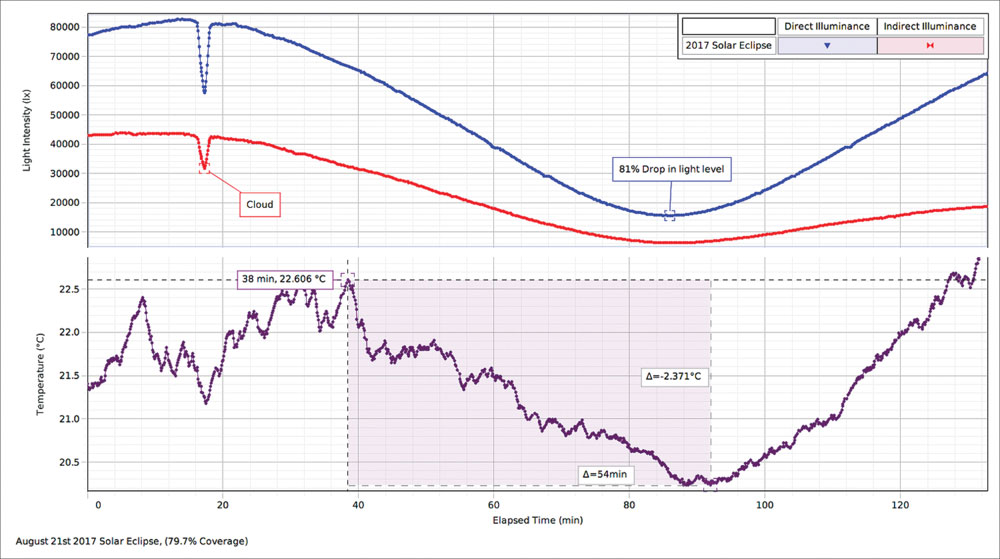

Eclipses aren’t only awe-inspiring to witness, they’re also an excellent opportunity for science! Find out what scientists (and PASCO!) learned from the 2017 eclipse, and mark your calendar for the upcoming solar eclipses!
What was the Great American Eclipse?
The Great American Eclipse was a total solar eclipse that occurred on August 21, 2017, and was visible across the United States. It was the first total solar eclipse visible from coast to coast in the US in almost a century. The path of totality, where the Moon completely blocked the Sun, passed through 14 states, starting in Oregon and ending in South Carolina. At its maximum point, viewers on Earth could experience the eclipse for around 2 minutes and 40 seconds.
The eclipse generated significant public interest, with millions of people traveling to witness the event and many others tuning in to live broadcasts. It also provided a special opportunity for scientists to study the Sun and its effects on Earth.
A Unique Opportunity for Scientific Discovery
The Great American Eclipse led to several scientific discoveries, many of which were only made possible by the unique conditions an eclipse creates. During a total solar eclipse, the Moon completely blocks the Sun’s light, allowing scientists to gather data about the Sun’s shape, structure, and its relationship with other phenomena, like solar wind. Researchers use a combination of tools to collect eclipse data, including ground-based and airborne instruments, as well as satellites that provide data about the Sun’s corona, magnetic field, and its impact on the Earth’s atmosphere and ionosphere.
What Did Scientists Learn from the 2017 Solar Eclipse?
Some of the most significant observations made during the Great American Eclipse regard the corona, the outermost part of the Sun that’s usually too dim to see.
For years, scientists had been puzzled by the fact that the corona is far hotter than the surface of the Sun. During the Great American Eclipse, researchers were finally able to determine just how hot the corona actually is. By measuring the temperature of the corona more accurately, scientists found that it was about one million degrees Celsius (1.7 million degrees Fahrenheit), which is much hotter than the Sun’s surface temperature of around 5,500 degrees Celsius (10,000 degrees Fahrenheit).
But that wasn’t all scientists observed. Researchers also studied the magnetic field of the corona and found it to be much more complex than previously thought. Just like Earth, the Sun has a magnetic field with north and south poles. They also discovered evidence of “coronal loops,” which are giant arcs of plasma that are trapped in the corona’s magnetic field.
The Great American Eclipse provided a rare opportunity for scientists to study the Sun’s corona in ways that are not possible under ordinary conditions. The next opportunity for such studies isn’t until October 14, 2023, when the Great North American Eclipse crosses our skies.
Weather Changes During the Great American Eclipse
Because the Moon’s shadow cools Earth during a solar eclipse, several atmospheric changes occur following the drop in temperature. The 2017 total solar eclipse produced some noticeable weather effects in areas located in the path of totality, particularly in the moments leading up to and during the period of totality.
While the amount of cooling varied depending on the location and the weather conditions at the time, some areas experienced a temperature drop of 6.6ºC! In addition to the reduced temperature, the Great American Eclipse also affected wind patterns. As the air temperature cooled, the density of the air changed, which in turn affected the way that air flowed around the area. This created a brief period of stillness and calm in some areas, as the usual winds died down.
Tracking Eclipse Weather Changes With PASCO Wireless Sensors
At PASCO, we made some observations of our own during the Great American Eclipse! Here in Northern California, we only experienced a partial eclipse, but the weather changes did not disappoint! Using a Wireless Weather Sensor with GPS, we measured and compared the relationship between Temperature (ºC) and Light Intensity (lux) over the duration of the eclipse. Check out our results below!

As the Moon covered the Sun, there was a sudden drop in light intensity, which was shortly followed by a reduction in temperature. Though we only experienced a partial eclipse, we still observed a drop in temperature of 2.37ºC!
Looking for ways to study the next eclipse with your students? Head over to our eclipse page to learn how to conduct this experiment for yourself!










